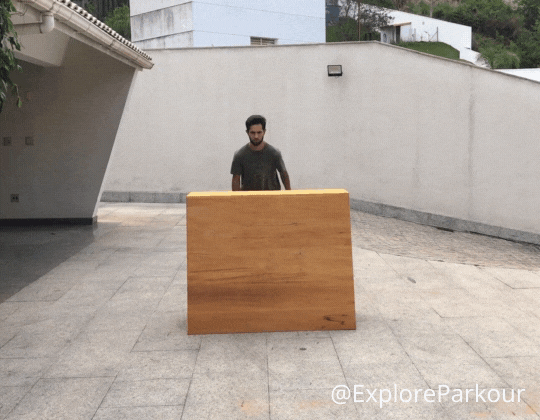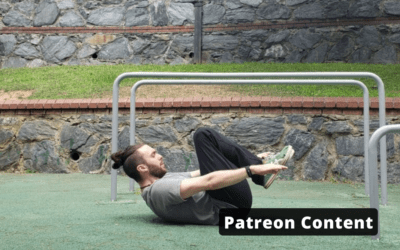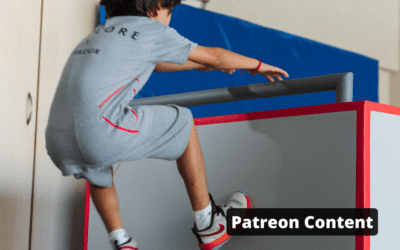Also known as: Safety Vault
Movement Pieces



 The basic sequence of micro-transitions in this move is…
The basic sequence of micro-transitions in this move is…
– Find an obstacle close to your hips height, with short length but wide enough to fit a contralateral linear self hold on it.
– Place yourself with enough run up as you would need to perform a Running Jump to the top of it.
– Move towards the obstacle straight in between your hand and foot placement targets.
– Take off using a Leg Swing technique and lean sideways so your hand can reach the obstacle without too much impact.
– Reach your step leg just enough to the side and tuck the take off leg. Now place your hand and foot on the top of the obstacle almost at the same time – foot should land just milliseconds before the hand.
– Stretch the tuck/thread leg all the way down to the other side of the obstacle and push yourself forward together with hand and foot so your weight can follow it.
– Try to get as close as you can to the ground with your thread leg to land softly and with control.
Common Problems – Take Off

This is usually the way beginners will perform their first Step Vault attempts, which is fine because it takes some time to get used to the micro transitions to be able to use only the peripheral vision to aim and place your foot/hand at the same time on the obstacle. With practice, you should notice that this specific take off will mess up your momentum and body position for a linear path of travel. Relying too much on your arm isn’t the safest and most efficient way to perform the Step Vault as well. However, there will be situations where this can be useful, deppending on your start position and the coming step/movement afterwards.

Stepping up on the obstacle and performing the Step Vault down is one extra micro transition in the middle of the movement. Beside slowing you down, your wrist might get more impact than it should as you need to lean sideways all the way to push yourself down. Try to lean sideways before you reach the obstacle so your hand can be closer to it.
Common Problems – Middle

If there’s no environmental limitation making you place your hand and foot too far apart, you should consider to analyse your body control during the middle/landing of this movement. Being too sideways during the Step Vault will give more weight to your arm and less utility to your foot. Too much of a gap will also decrease your hips height and your thread leg might hit the obstacle. Working on Back and Forth Step Vault progressions on the ground/obstacle will help you to figure out the best gap size to bring your leg through.

The distance between your hand and foot on the obstacle is a big key to perform a comfortable Step Vault. In some situations, the environment can limit this distance and you will probably feel the difference. Here your foot will make most of the effort and there won’t be enough weight on your hand to push the obstacle. Your thread leg can also get stuck when you try to pass it through the small gap. Working on Back and Forth Step Vault progressions on the ground/obstacle will help you to figure out the best gap size to bring your leg through.

This small detail can change your Step Vault efficiency and utility forever. The hand placement with external rotated arm will allow yourself to lean back more than usual on that side of your body. Having your hand on the obstacle until you reach the floor with your feet can give you a feeling of control and comfort. On the other hand, you might end up landing sideways because of that. With practice, if your goal is to leave the obstacle behind without loosing too much momentum, you should be able to push the obstacle and keep your weight forward. This is when the hand placement with fingers pointing forward will physically help.
Common Problems – Landing

Be aware to push yourself out of the box with hand and foot at the same time as you reach the ground with your thread leg. Then, balancing the pushing strength on each limb will help you to get your landing as straight as possible. This can be practiced with Step Vault Down progressions. Having your pushing hand externally rotated could be the cause of this problem as well.

The goal to be able to keep momentum after landing a Step Vault is to do it as smooth as possible. Knowing that, the less impact you bring to the ground will be better for you. Try to reach your thread leg as close to it as possible and push yourself forward so your weight doesn’t load that leg too much. Practicing on obstacles just bellow your hips height can help.
Related Exercises
Laying Arch
Where should I feel this Exercise? On your Glutes, Lower, Mid and Upper Back mostly. What’s the Main Purpose? We usually float in between hyper extending and flexing our spine. This exercise allow you to strenghten the muscles needed to keep your torso straight or...
Tuck Up
Where should I feel this Exercise? Abs and hip flexors predominantly. Can also use the shoulders and pecs a bit for the arm movement. What’s the Main Purpose? Helps develop power for jumps, flips and other movements (like the cat pass) that require an explosive...
Push Up
Where should I feel this Exercise? Pecs, shoulders, triceps, scapulas, abs, and potentially glutes. What’s the Main Purpose? The push up is one of the first pushing exercises people will start with to build up their upper body pushing strength. For parkour this...
Related Techniques
Cat Leap
Also known as: Cat, Arm Jump, Cat JumpMovement Pieces The basic sequence of micro-transitions in this move is… - Like a Precision Jump, start with your toes at the edge of the obstacle. Squat - close to 1/3 - and bring your arms down and back as you lean forward -...
Cat Pass
Also known as: Kong, Monkey Vault or Saut de Chat.Movement PiecesThe basic sequence of micro-transitions in this move is… - Choose a stable obstacle close to your hip height, with short width and enough space to place your hands on the top. - Give yourself enough...
Dash Vault
Movement Pieces The basic sequence of micro-transitions in this move is… -Choose a sturdy relatively thin obstacle around your belly button height. -You’ll want to take off further away from the obstacle than for most vaults with a running jump start and a tucked L...





















